Content
- Chemical composition
- Nutritional value and calorie content
- The benefits of parsnips for the body
- Impact on digestion
- Effects on hormonal levels
- Benefits for the kidneys
- Effects on the respiratory system
- The benefits of parsnips for weight loss
- With male weakness
- With baldness
- With angina
- Harm of parsnips and contraindications to use
- Parsnip in folk medicine
- Parsnip juice
- Parsnip leaf decoction
- Parsnip root decoction
- Parsnip tea
- Infusion of parsnips
- Application in cosmetology
- Parsnip-based preparations
- Video about the plant Parsnip
Parsnips contain many useful substances, due to which it is used in various industries - cooking, pharmacology, cosmetology, folk medicine. To get the most out of the use of a plant, it is important to study in detail the features of its use, benefits and possible harm.
Chemical composition
Parsnip is a plant, the benefits and harms of which directly depend on its composition.
It contains the following components:
- Micro and macro elements in the form of potassium, chlorine, phosphorus, sulfur, silicon, calcium, sodium, manganese, selenium, copper and iron.
- Fiber and starch.

- Vitamins E, A, C and group B.
- Saturated and unsaturated fatty acids.
- Essential oils that impart a specific flavor to root vegetables.
- Fructose, which provides the sweetness of the vegetable.
- Organic acids
Nutritional value and calorie content
Parsnip is a low-calorie product - 100 g of fresh vegetable contains only 47 kcal.
And the nutritional value is as follows:
- 1, 4 g are proteins;
- 0.5 g is fat;

- 9.2 g carbohydrates.
The benefits of parsnips for the body
It is the rich composition that determines the health benefits of parsnips. Its action is directed to all systems of the body. It manifests itself in improving the well-being and health of a person in general.
Impact on digestion
The presence of essential oils in a high concentration has a stimulating effect on the production of gastric juice and digestive enzymes.
As a result, it is noted:
- improved and increased appetite;
- acceleration of the process of digestion of food;
- improvement of metabolic processes.
Effects on hormonal levels
Biologically active components in parsnips stimulate the production of certain hormones. Therefore, it is often used in traditional medicine to improve the balance of hormones. This helps to reduce irritation, reduce stress and prevent mood swings, which is especially true for women during menstruation and menopause.
Benefits for the kidneys
Eating parsnips helps dissolve kidney stones and also prevents urine from being reabsorbed. As a result, the excretory system begins to work better and function. Also, the plant has a pronounced anti-inflammatory effect. Therefore, parsnip-based products are used for cystitis, prostatitis, inflammation of the urinary and gall bladder. It is important not to overuse parsnips during treatment, as this can lead to blockage of the urinary tract.
Effects on the respiratory system
The high concentration of vitamin C and carotene improves the functioning of the immune system and minimizes the likelihood of colds. They also have a positive effect on the respiratory system. For example, the function of the lungs and the condition of the bronchi improves in asthma and tuberculosis. In such cases, decoctions and infusions are most often prepared from parsnips.
The benefits of parsnips for weight loss
Thanks to the high fiber content, parsnips are kept feeling full for a long time.
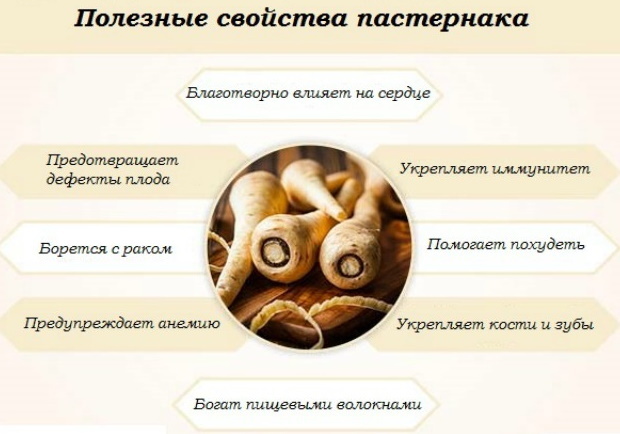
Another benefit of the plant for weight loss is due to:
- removing excess fluid from the body and eliminating puffiness;
- normalization of metabolism;
- cleansing the body of toxins and toxins;
- lowering cholesterol and blood sugar levels.
For weight loss, a special diet is used, which must be followed during the week. During this period, in addition to parsnip dishes (there should be at least 2 of them in the diet), the use of fresh fruits and vegetables, lean meat, eggs and dairy products is allowed. Also, when dieting, it is recommended to follow a drinking regimen and drink at least 1.5 liters of clean water.
With male weakness
In case of problems with potency, the use of parsnip infusion is effective. It is prepared as follows:
- Chop the parsnip root.
- The received raw materials in the amount of 2 tbsp. l. pour 1 tbsp. boiling water.
- The mixture should be insisted for 3 tsp.
- After the specified time, strain the infusion.
The prepared product is consumed before meals 3 r. a day for 1/3 tbsp.
With baldness
The biologically active substances in parsnips help fight hair loss. For this, it is recommended to use a decoction of vegetable leaves.
Preparation of the product includes the following stages:
- Parsnip leaves in the amount of 2 tbsp. l. pour 1 liter of hot water (must be boiled).
- Put the resulting mixture on fire and boil for 15 minutes.
- After that, the broth is infused for 3 hours.
The prepared product is consumed in 1 tbsp. l. three times a day. To enhance the effect, you can lubricate problem areas with broth. It should be applied in a circular motion to enhance circulation.
With angina
For angina pectoris, parsnip juice is used. It helps not only to relieve seizures, but also to prevent the occurrence of this phenomenon and other cardiovascular diseases. To prepare the medicine, you need to take 2 parts of carrot juice and 1 part of rosehip syrup for 3 parts of parsnip juice. The resulting mixture must be mixed well and consumed 4 r. a day 30 minutes before meals, 2 tbsp. l. The course of treatment is, on average, 2 weeks. For the purpose of prevention, you need to do 3-4 courses per year.
Harm of parsnips and contraindications to use
With the specified benefits, parsnips can harm the body.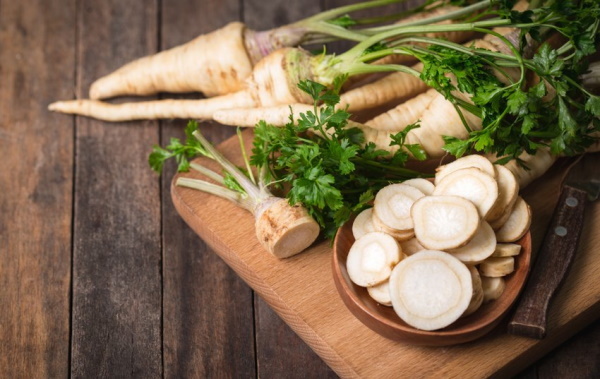
Therefore, the use of plant-based products should be abandoned when:
- the presence of a disease of the digestive system in the acute period;
- cirrhosis of the liver;
- urolithiasis in the later stages (the plant will stimulate the removal of stones, which is contraindicated in this situation);
- individual intolerance to the vegetable;
- reduced pressure;
- hypersensitivity to the sun. Parsnips contain substances that enhance the effect of ultraviolet radiation. Therefore, even when you touch the plant on sunny and hot days, you can get burned.
Also, the plant is not recommended for use in childhood and old age in order to avoid sudden changes in pressure.
Excessive consumption of parsnips can lead to health problems such as:
- violation of the digestive tract;
- increased nervous irritability or drowsiness (depending on the type of nervous system);
- the occurrence of allergic reactions on the skin in the form of itching, redness, peeling, etc.
Parsnip in folk medicine
Parsnip is a plant (the benefits and harms depend on the correct use), which is used in folk medicine. For this purpose, almost all parts of the vegetable are used. Various decoctions, infusions, tinctures and other means are prepared from them. They should be used with caution and it is recommended to consult with your doctor before use.
Parsnip juice
The plant sap is produced exclusively from root crops, since there is a high concentration of biologically active substances in the leaves and seeds. They can provoke side effects.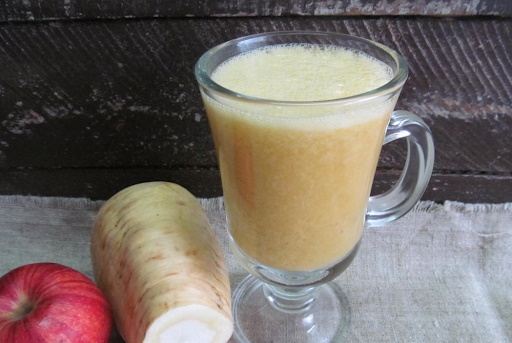
The benefits of parsnip juice include:
- improving the tone of the body with a general loss of strength;
- strengthening the walls of capillaries and blood vessels;
- reduction of pain syndrome;
- improved sexual function.
Also, the juice has a pronounced expectorant effect, helping to quickly remove phlegm from the bronchi.
With a general loss of strength and juice, it is recommended to consume 2 tsp. l. three times a day 30 minutes before meals. The tool is also used externally for vitiligo - they lubricate the affected skin areas 4 r. a day for 2 months.
Parsnip leaf decoction
A decoction from a vegetable is used most often due to its simplicity and ease of preparation.
And for this you should:
- 1 tbsp. l. plant leaves in a dry, chopped form, pour 1 liter of boiling water.
- Boil the resulting mixture over low heat for half an hour.
- After that, infuse the broth for 24 hours, and then strain.

Apply the remedy three times a day for 1 tbsp. l. The dosage may vary depending on the type of disease.
Parsnip root decoction
Also, the broth is prepared from the parsnip root. The table below shows the features of preparing and taking the product for various health problems. It should be noted that in some cases, the decoction is more effective in comparison with the drugs of traditional medicine.
| Purpose of admission | How to cook, use the broth? |
| Cough, colds | The broth helps to eliminate the first signs of disease. To prepare it, you should: 1. Grind the root of the vegetable to obtain 2 tbsp. l. raw materials. 2. In 1 st. dissolve boiling water 5 tbsp. l. Sahara. 3. Pour the chopped parsnip root with the resulting mixture and mix. 4. Insist the remedy for 10 hours. Use the cooked broth in 2 tbsp. l. 5 p. per day. |
| Depression | To prepare the broth, you should: 1. Grind 1 parsnip root. 2. After that, the resulting mixture is combined with mint leaves in the amount of 5 pieces, linden inflorescences (5 pieces are also needed). 3. Add 50 g of honey to the mixture and pour in all 2 liters of water. 4. Put the resulting mixture on fire and boil for 30 minutes. 5. Insist the resulting broth for 24 hours. |
| Disruption of bowel function | Chopped parsnip root (requires 1 tbsp. l.) pour 2 tbsp. boiling water. The resulting mixture is boiled over low heat for 10 minutes, and then infused for 1 hour. Before use, filter the broth and take three times a day for ¼ tbsp. before eating. |
| With hair loss | To prepare the product, you will need 2 parsnips and carrots each. Further it is necessary: 1. Squeeze the juice from the root vegetables. 2. Dilute the juice with 0.5 liters of boiled water. 3. Boil the resulting mixture for 30 minutes. 4. Insist a little broth. Apply the prepared product in 0.5 tbsp. 3 p. a day before meals. |
| Allergy | A decoction of dry parsnip roots is prepared as follows: 1. Pour 10 g of crushed root of a plant with 1 liter of water. 2. Boil the resulting mixture and boil for 4-5 minutes. 3. Cool the broth and strain. 4. Add the prepared product to the bath to warm water. The treatment procedure should not exceed 15 minutes. |
| Burns | In this case, boiled parsnip root is used. After boiling, it needs to be cooled and then converted into puree. The resulting mixture is applied to the affected skin. This helps relieve pain and redness. |
Parsnip tea
Parsnip tea has a wide range of effects:
- stabilizes the nervous system;
- gives energy to the body;
- stimulates the production and restoration of melanin;
- normalizes hormonal levels;
- eliminates insomnia;
- relieves muscle spasms.
Parsnip is a potent remedy that can help eliminate hallucinations and signs of delirium tremens.
You need to prepare tea from a plant as follows:
- Dried parsnip leaves (requires 3 tbsp. l.) is combined with 1 tbsp. l. linden blossom.
- Pour the resulting mixture with 1 liter of boiling water.
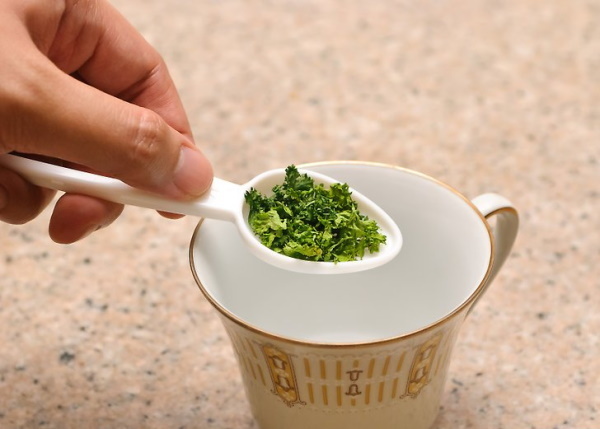
- Insist the product for 30 minutes, and then strain.
- Before use, add 1 tbsp to tea. l. honey.
You can drink the remedy instead of the usual tea 2-3 r. per day for 1 tbsp. It is recommended to brew new tea daily for maximum benefit.
Infusion of parsnips
Parsnip infusion has different preparation variations, based on the purpose of use.
However, the principle of its preparation is in most cases the same:
- Chop the large parsnip root.
- Then place it in a suitable container (preferably made of glass) and pour 500 ml of vodka.
- The mixture should be insisted for 1 month. in a place without access to sunlight. Periodically, the infusion is shaken and stirred.
With vasospasm, it is recommended to use 1 tsp. l. infusion three times a day.
Application in cosmetology
Parsnip is a plant (the benefits and harms in folk medicine have been proven by numerous reviews), which is actively used in cosmetology also thanks to its rich vitamin and mineral composition:
- Essential oils help fight acne, inflammation of the skin, smooth wrinkles and reduce the appearance of cellulite.
- The presence of antioxidants protects the skin from external factors.
- Ascorbic acid improves complexion and has a whitening effect.
- Vitamins E and A provide deep skin nutrition and stimulate collagen production.
- B vitamins accelerate the skin regeneration process, make it more elastic and protect against premature aging.
- Silicon and sulfur in the composition improve the appearance and condition of hair, as well as prevent brittle nails. Therefore, the vegetable can be added to the diet by adding it to salads or soups. The main thing is not to exceed the daily norm, which is 150 g.
Most often, parsnips are added to the composition of caring face masks. For example, in a remedy for relieving inflammation.
It is prepared as follows:
- Grind 1 parsnip root by rubbing on a coarse grater.
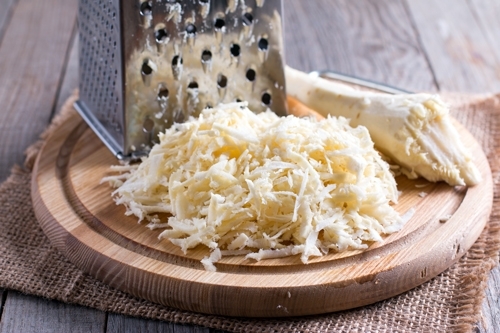
- Add 5 chopped mint leaves to the resulting gruel.
- Mix and grind the ingredients to make the juice stand out.
- Add 1 tbsp to the resulting mixture. l. honey and 2 tbsp. l. vegetable oil.
- Apply the prepared mask to clean skin for 10 minutes.
An anti-wrinkle parsnip mask has a good effect. Additionally, it provides deep skin nourishment.
To prepare a care product, you must:
- Grind the medium-sized parsnip root with a grater.
- Add 20 g of vegetable oil, 1 egg yolk and 1 tsp to the resulting raw material. l. honey.
- Mix all components and dilute with 400 ml of water.
- Place the infusion mask in a warm place for 1 hour.
- After the specified time, apply the mask to clean skin and leave to act for 20 minutes.
In case of hair loss, rubbing parsnip juice into the roots. It promotes increased blood flow and strengthens the hair follicles. It is recommended to carry out this procedure in a bath or sauna, when the pores are as open and cleansed as possible.
When using products with parsnips, the main thing is not to overexpose them on the skin, since with prolonged exposure they can increase sensitivity and cause irritation.
Parsnip-based preparations
Parsnip is a plant (benefits and harms are assessed individually) containing furocoumarins. These substances are used as a basis for the manufacture of pharmaceutical preparations with photosensitizing (increasing sensitivity to UV radiation) and antispasmodic effects. They are unique in composition due to the presence of a number of specific enzymes and other useful substances in parsnips. One of the most popular medicines is Pastinacin.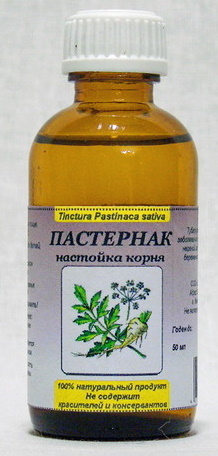
It has a wide range of effects on the body:
- Has a calming effect.
- Eliminates spasms of blood vessels and muscles.
- It relieves attacks with angina pectoris and is used for ischemic disease.
- Heals neuroses.
The drug can be taken only as directed by a doctor who can select the required dosage and duration of the course of treatment. It usually takes 14-30 days.
Beroxan is also a parsnip-based medicine. Its action is aimed at stimulating the production of melanin under UV irradiation and restoring the sensitivity of the skin to the action of sunlight. The drug also activates the process of restoring skin pigmentation and stimulates hair growth in case of alopecia (pathological hair loss).
But most often it is used for vitiligo. The agent in the form of a 0.25% solution is used externally, applying it to the affected skin evenly and in a circular motion. It is combined with irradiation with a quartz lamp.
Also, the drug is available in the form of tablets. They are taken orally for 1 hour. before exposure to the lamp.
When using the product, a number of side effects can be observed:
- headaches and dizziness;
- heart palpitations;
- nausea, sometimes vomiting;
- swelling and redness of the skin.
Parsnip is an affordable way to heal the body and help in the treatment of a number of diseases. The maximum benefit from using the plant can be obtained if all recommendations are followed. Before using the parsnip plant, it is advisable to consult a doctor in order not to harm your health.
Video about the plant Parsnip
Useful properties of parsnips:



